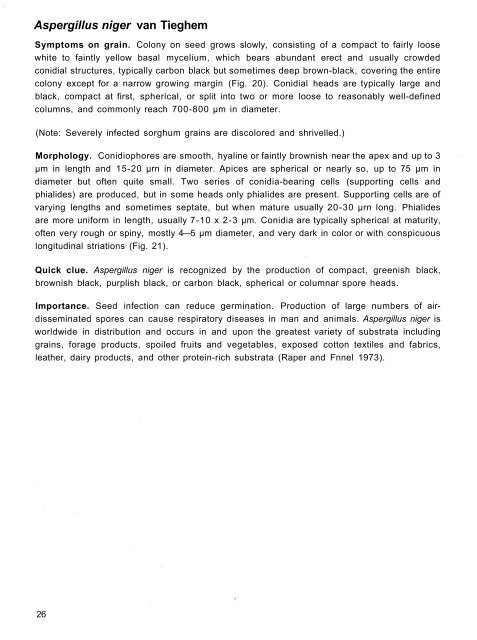A Pictorial Guide for the Identification of Mold ... - OAR@ICRISAT
A Pictorial Guide for the Identification of Mold ... - OAR@ICRISAT
A Pictorial Guide for the Identification of Mold ... - OAR@ICRISAT
You also want an ePaper? Increase the reach of your titles
YUMPU automatically turns print PDFs into web optimized ePapers that Google loves.
Aspergillus niger van Tieghem<br />
Symptoms on grain. Colony on seed grows slowly, consisting <strong>of</strong> a compact to fairly loose<br />
white to faintly yellow basal mycelium, which bears abundant erect and usually crowded<br />
conidial structures, typically carbon black but sometimes deep brown-black, covering <strong>the</strong> entire<br />
colony except <strong>for</strong> a narrow growing margin (Fig. 20). Conidial heads are typically large and<br />
black, compact at first, spherical, or split into two or more loose to reasonably well-defined<br />
columns, and commonly reach 700-800 μm in diameter.<br />
(Note: Severely infected sorghum grains are discolored and shrivelled.)<br />
Morphology. Conidiophores are smooth, hyaline or faintly brownish near <strong>the</strong> apex and up to 3<br />
μm in length and 15-20 μrn in diameter. Apices are spherical or nearly so, up to 75 μm in<br />
diameter but <strong>of</strong>ten quite small. Two series <strong>of</strong> conidia-bearing cells (supporting cells and<br />
phialides) are produced, but in some heads only phialides are present. Supporting cells are <strong>of</strong><br />
varying lengths and sometimes septate, but when mature usually 20-30 μrn long. Phialides<br />
are more uni<strong>for</strong>m in length, usually 7-10 x 2-3 μm. Conidia are typically spherical at maturity,<br />
<strong>of</strong>ten very rough or spiny, mostly 4—5 μm diameter, and very dark in color or with conspicuous<br />
longitudinal striations (Fig. 21).<br />
Quick clue. Aspergillus niger is recognized by <strong>the</strong> production <strong>of</strong> compact, greenish black,<br />
brownish black, purplish black, or carbon black, spherical or columnar spore heads.<br />
Importance. Seed infection can reduce germination. Production <strong>of</strong> large numbers <strong>of</strong> airdisseminated<br />
spores can cause respiratory diseases in man and animals. Aspergillus niger is<br />
worldwide in distribution and occurs in and upon <strong>the</strong> greatest variety <strong>of</strong> substrata including<br />
grains, <strong>for</strong>age products, spoiled fruits and vegetables, exposed cotton textiles and fabrics,<br />
lea<strong>the</strong>r, dairy products, and o<strong>the</strong>r protein-rich substrata (Raper and Fnnel 1973).<br />
26
















